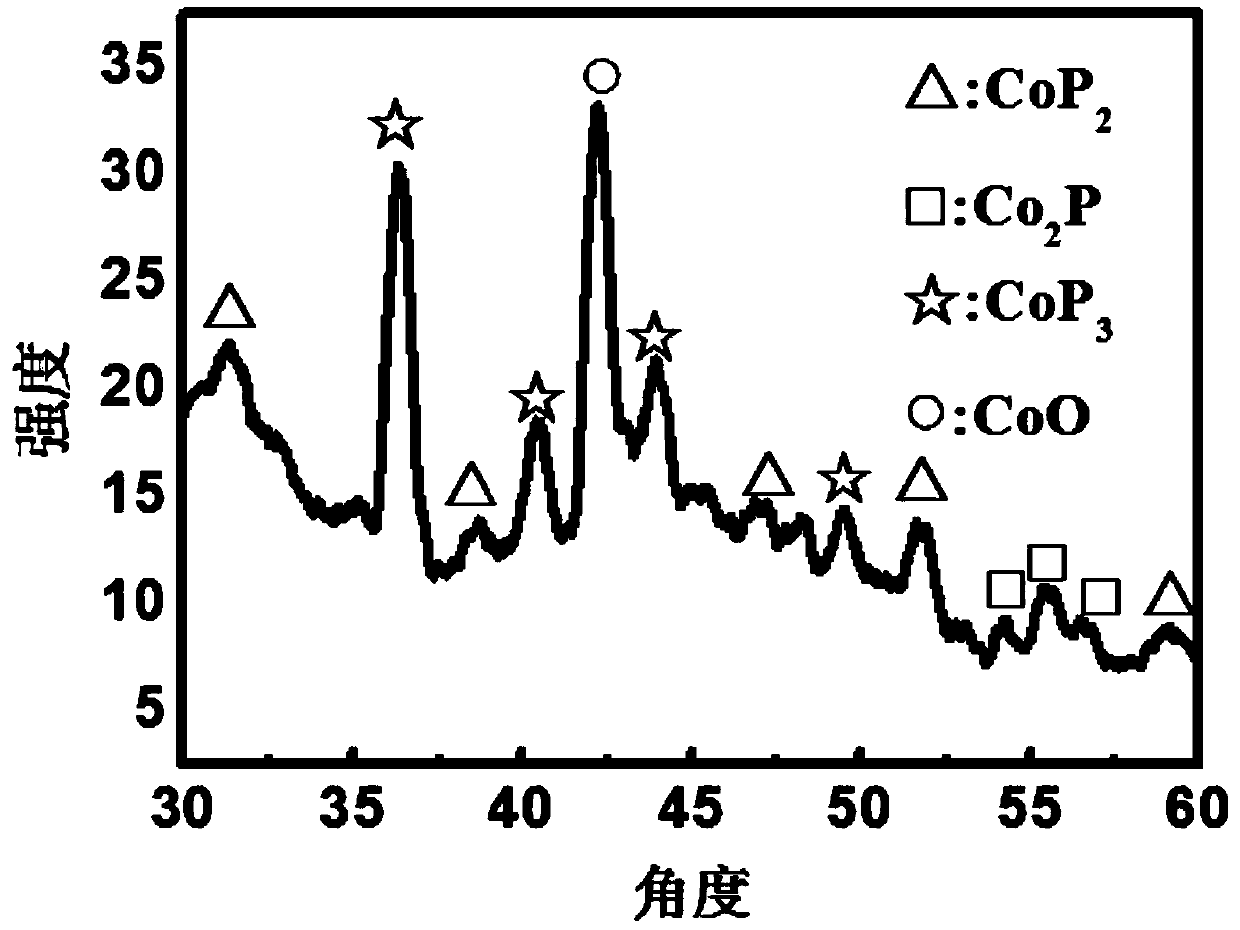Cobalt phosphate biomass carbon composite material and preparation method and application thereof
A composite material, biomass carbon technology, applied in electrochemical generators, electrical components, battery electrodes, etc., can solve the problems of specific capacity attenuation, affecting the application of biomass carbon materials, etc., to improve cycle life, easy to implement, heavy good effect
- Summary
- Abstract
- Description
- Claims
- Application Information
AI Technical Summary
Problems solved by technology
Method used
Image
Examples
Embodiment 1
[0028] Preparation and application of cobalt phosphide / biomass carbon composite material of embodiment 1
[0029] (1) Biomass carbon film preparation: freshly picked Magnolia magnificata leaves were washed 2-3 times with a mixed solution of acetone and deionized water at a ratio of 1:1, and dried in an oven at 60°C for 2 hours. Place the dried Magnolia glabrata leaves between graphite sheets at a heating rate of 3°C / min, and raise the temperature to 800°C under N 2 After being kept in the atmosphere for 2 hours, it was naturally cooled to room temperature, then placed in 3mol / L KOH aqueous solution for 2 hours, and then placed in 1mol / L HCl aqueous solution for 10 hours to obtain a biomass carbon film.
[0030] (2) Preparation of electrolyte: sodium hypophosphite and sodium sulfate are mixed and dissolved in cobalt sulfate heptahydrate solution, the pH value of the solution is adjusted with sulfuric acid, and the pH value is guaranteed to be 2.5 to obtain electrolyte; the elec...
Embodiment 2
[0036] Preparation and application of embodiment 2 cobalt phosphide / biomass carbon composite material
[0037] (1) Wash the freshly picked leaves of Magnolia magnolia 2-3 times with a mixed solution of acetone and water at a ratio of 1:1. Dry in an oven at 60°C for 2 hours. Place the dried blades in a tube furnace, feed nitrogen protective gas with an air intake of 0.2L / min, and heat up to 800°C at a rate of 2°C / min, keep it warm for 2 hours, and then cool it down to room temperature naturally. Then placed in 2mol / L KOH aqueous solution for 2 hours, and then placed in 2mol / L HCl aqueous solution for 6 hours to obtain biomass carbon film.
[0038] (2) Preparation of electrolyte: sodium hypophosphite and sodium sulfate are mixed and dissolved in cobalt sulfate heptahydrate solution, the pH value of the solution is adjusted with sulfuric acid, and the pH value is guaranteed to be 2.5 to obtain electrolyte; the electrolyte contains 0.2mol The sodium sulfate of / L, the sodium hyp...
Embodiment 3
[0042] Preparation and application of embodiment 3 cobalt phosphide / biomass carbon composite material
[0043] (1) Wash freshly picked leaves of Magnolia magnolia with a mixed solution of acetone and water at a ratio of 1:1 for 2-3 times, and dry them in an oven at 60° C. for 2 hours. Place the dried blades in a tube furnace, feed nitrogen protective gas at an air flow rate of 0.2 L / min, and heat up to 800°C at a rate of 2°C / min, keep it warm for 2 hours, then cool naturally to room temperature, and then Place in 2mol / L KOH aqueous solution for 2 hours, then place in 1mol / L HCl aqueous solution for 8 hours to obtain biomass carbon film.
[0044] (2) Preparation of electrolyte: mix sodium hypophosphite and sodium sulfate and dissolve in cobalt sulfate heptahydrate solution, adjust the pH value of the solution with sulfuric acid, and ensure that the pH value is 3 to obtain electrolyte; the electrolyte contains 0.4mol The sodium sulfate of / L, the sodium hypophosphite of 0.2mol / ...
PUM
| Property | Measurement | Unit |
|---|---|---|
| Charge and discharge specific capacity | aaaaa | aaaaa |
Abstract
Description
Claims
Application Information
 Login to View More
Login to View More - R&D
- Intellectual Property
- Life Sciences
- Materials
- Tech Scout
- Unparalleled Data Quality
- Higher Quality Content
- 60% Fewer Hallucinations
Browse by: Latest US Patents, China's latest patents, Technical Efficacy Thesaurus, Application Domain, Technology Topic, Popular Technical Reports.
© 2025 PatSnap. All rights reserved.Legal|Privacy policy|Modern Slavery Act Transparency Statement|Sitemap|About US| Contact US: help@patsnap.com



